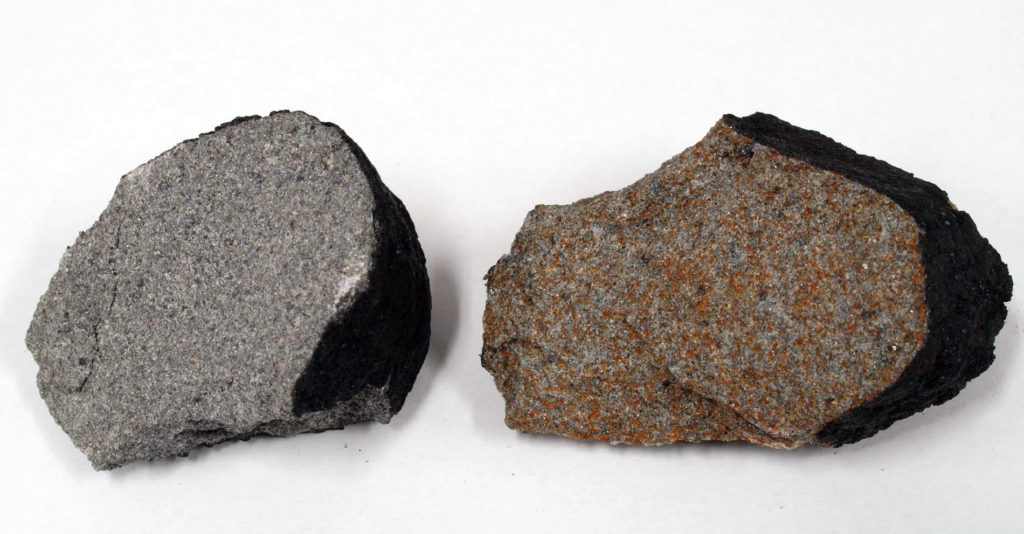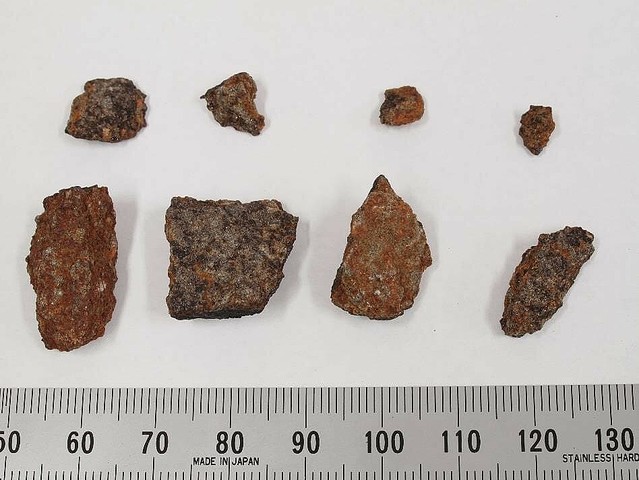Narashino
NARASHINO (習志野市, Narashino-shi) meteorite fall (350 g, H5, S1) in Narashino and Funabashi (船橋), Chiba Prefecture, Japan on 1st July at 17.32.03-10 UT (2nd July, 2.32.03-10 a.m. JST)

The two larger recomposed fragments of the Narashino meteorite. Photo: National Museum of Nature and Science
On 13 July 2020 the National Museum of Nature and Science reported in a press release that on 1st July at 17.32.03-10 UT (2nd July JST) a meteorite fell into a condominium in Narashino, Chiba Prefecture, in Japan. At 2.32.03-10 a.m. JST a large fireball of about 7 seconds was widely seen and detonation sounds were heard above the Kanto region. The meteorite, an ordinary chondrite (H5), fragmented when it hit the railing of a shared corridor facing the courtyard in front of a door of an apartment at location 35°41’26″N, 140°01’51″E and fragmented on impact.
気が付いてよかったなと思っています。手元にある隕石は、博物館などで展示してもらいたいです
I’m glad I noticed. I would like to see the meteorites at hand displayed at museums and other places. (Finder of the meteorite.)
The first meteorite fragment weighing 63 grams (45 x 30 x 25 mm) was found by a woman living in an apartment. She was sleeping at home on the second floor of her apartment when she woke up and heard something impacting the railing in the corridor. She was too afraid to go out and have a look because she thought someone had thrown a stone at her home. The next morning she found a four-centimetre stone in the corridor and noticed the dent in the railing. Scratches from the impact could still be seen on the railing of the corridor. She did not know the stone was special and left it where it was. It wasn’t until she became aware of media reports about the fireball during the night that she went out to pick the meteorite up and contacted a nearby museum. On 4 July the woman and the caretaker looked for more fragments of the meteorite outside in the courtyard of the first floor and then found a second fragment (70 grams, 50 x 35 x 20 mm) which had been exposed to terrestrial weathering for two days and already showed obvious signs of corrosion. Additionally, another 15 smaller pieces (22 grams) were found on the terrace of the fifth floor. Senior researcher Naoki Takahashi visited the fall site on 5 July. He took the meteorite and brought it to National Science Museum for a first analysis. On 1 November 2020 the fall was added to the MetBull as Narashino (H5, S1). From 10 November to 13 December 2020 Narashino meteorite fragments were exhibited together with a fragment of the impacted roof tile at the National Science Museum in Ueno, Tokyo while other fragments of the meteorite were exhibited at the Chiba Prefectural Central Museum from 10 November 2020 to 28 February 2021.

The first unweathered fragment (63 grams, 45x30x25 mm) of the Narashino meteorite. Photo: National Museum of Nature and Science

The second weathered fragment (70 grams, 50x35x20 mm) of the Narashino meteorite. Photo: National Museum of Nature and Science

The two larger fragments of the Narashino meteorite. Photo: National Museum of Nature and Science

The two larger fragments of the Narashino meteorite. Photo: National Museum of Nature and Science

The small impact mark (~ 1cm) of Narashino 1 on the metal railing of the corridor. Image: News Watch 9, NHK
The Funabashi (船橋) find (Narashino meteorite 2)
On 3 August 2020 the National Museum of Nature and Science, Tokyo announced that on 22 July while repairing roof tiles of an apartment at location 35°42’01″N, 140°02’34″E in Funabashi, Chiba prefecture, 1.5 kilometres northeast of the fall site in Narashino, other meteorite fragments were discovered by the 39-year old real estate management company’s employee Yosuke Kato (加藤洋介さん) next to broken roof tiles on the ground at the edge of a parking lot. Kato first thought it was an ordinary stone but when he showed the stony fragments to the man of a roof tile shop where he wanted to buy new roof tiles the man said “Maybe it is a meteorite”. Kato searched the internet for information and then handed the meteorite fragments over to the 31-year old male owner of the apartment whose roof tiles had been impacted. Eight smaller fragments (up to 5 grams) and two larger fragments weighing 95 and 73 grams, in total 183 grams of weathered meteorite fragments were found.

Two larger weathered fragments of the Funabashi find. Photo: National Museum of Nature and Science

Two larger weathered fragments of the Funabashi find. Photo: National Museum of Nature and Science

The broken roof tiles of the house in Funabashi. Photo: Yosuke Kato (加藤洋介さん) / National Museum of Nature and Science
The exhibitions
From 10 November to 13 December 2020 six meteorite fragments of Narashino 1 and five fragments of Narashino 2 (Funabashi) were exhibited together with a fragment of the impacted roof tile at the National Science Museum in Ueno, Tokyo. Video: TBS News
Six fragments of Narashino 1 and five fragments of Narashino 2 (Funabashi) were exhibited at the Chiba Prefectural Central Museum from 10 November 2020 to 28 February 2021. Video: ChibaTV
Media
Video: NHK (5 August 2020)
Video: ANNnewsCH (3 August 2020)
The bolide
The luminous trail of the bolide recorded from a camera (TKx) on a balcony in Tokyo . Video: Kagaya
The luminous trail of the bolide recorded by a camera in Tokyo Setagaya (TK8). Video: SonotaCo
The video above was recorded with a private home camera (KNB) in Fujisawa (or Hiratsuka ?), Kanagawa Prefecture. Video: Daichi Fujii
The bolide recorded from Iwata City, Shizuoka (SZ2), ~34°43’15.3″N 137°51’04.5″E. Video: Iwata Minami High School
The bolide recorded from Kawasaki. Bottom is south, left is east. Video: gotoranosuke
Video of the bolide recorded with Tomi City Observatory’s Automatic Camera Southeast, Yamanashi, Sky over Shizuoka.
The luminous trail of the bolide and additional data. Video: Kagaya (10 July 2020)

The bolide captured by a skycam of the Akeno Observatory (35° 47′ N, 138° 30′ E)
Bolide trajectory
The bolide was recorded by at least nine cameras, including five SonotaCo cameras including one in Tokyo Setagaya (TK8) and one in Fujisawa (KNB). According to a current estimation the luminous trail of the bolide started at an altitude of about 85 km above Ashigaragami-gun, Kanagawa Prefecture, and ended at an altitude of about 23 km east of Urayasu, Chiba Prefecture. The expected fall area is mainly in Nagasaku-cho, Hanamigawa-ku, Chiba City, Chiba Prefecture.
Published: 13 July 2020


































